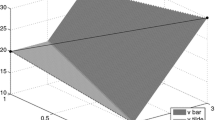Abstract
The single-period unit commitment problem has significant applications in electricity markets. An efficient global algorithm not only provides the optimal schedule that achieves the lowest cost, but also plays an important role for deriving the market-clearing price. As of today, the problem is mainly solved by using a general-purpose mixed-integer quadratic programming solver such as CPLEX or Gurobi. This paper proposes an extremely efficient global optimization algorithm for solving the problem. We propose a conjugate function based convex relaxation and design a special dual algorithm to compute a tight lower bound of the problem in \({\mathcal {O}}(n\log n)\) complexity. Then, a branch-and-bound algorithm is designed for finding a global solution to the problem. Computational experiments show that the proposed algorithm solves test instances with 500 integer variables in less than 0.01 s, whereas current state-of-the-art solvers fail to solve the same test instances in one hour. This superior performance of the proposed algorithm clearly indicates its potential in day-ahead and real-time electricity markets.

Similar content being viewed by others
Notes
The distributions of parameters \(c_i\) and \(u_i\) in our test instances are generated according to the data in MATPOWER with some modification. The original data of \(c_i\) in MATPOWER ranges from 150 to 800, and the proposed algorithm is able to solve most of the instances with data in this range by just one enumeration. Hence, we increase the range of \(c_i\) from [150, 800] to [200, 1000], and set \(u_i\) to [100, 300] in order to generate harder test instances.
References
Dai Y-H, Fletcher R (2006) New algorithms for singly linearly constrained quadratic programs subject to lower and upper bounds. Math Program 106:403–421
Edirisinghe C, Jeong J (2017) Tight bounds on indefinite separable singly-constrained quadratic programs in linear-time. Math Program 164:193–227
Fang S-C, Xing WX (2013) Linear conic optimization. Science Press, Beijing
Galiana FD, Motto AL, Bouffard F (2003) Reconciling social welfare, agent profits, and consumer payments in electricity pools. IEEE Trans Power Syst 18:452–459
Garey MR, Johnson DS (1979) Computers and intractability: a guide to the theory of NP-completeness. W.H. Freeman, San Francisco
Gribik PR, Hogan WW, Pope SL (2007) Market-clearing electricity prices and energy uplift. Working paper, John F. Kennedy School of Government, Harvard University
Hogan WW, Ring BJ (2003) On minimum-uplift pricing for electricity markets. Working paper, John F. Kennedy School of Government, Harvard University
Jiang DR, Powell WB (2016) Optimal hour-ahead bidding in the real-time electricity market with battery storage using approximate dynamic programming. INFORMS J Comput 27:525–543
Lorca A, Sun XA, Litvinov E, Zheng T (2016) Multistage adaptive robust optimization for the unit commitment problem. Oper Res 64:32–51
Liberopoulos G, Andrianesis P (2016) Critical review of pricing schemes in markets with non-convex costs. Oper Res 64:17–31
Momoh JA (2001) Electric power system applications of optimization (Power Engineering (Willis)). CRC Press, Boca Raton
O’Neill RP, Sotkiewicz PM, Hobbs BF, Rothkopf MH, Stewart WR Jr (2005) Efficient market-clearing prices in markets with nonconvexities. Eur J Oper Res 164:269–285
Ott A (2010) Unit commitment in the PJM day-ahead and real-time markets. http://www.ferc.gov/eventcalendar/Files/20100601131610-Ott. Accessed 22 April 2012
Pardalos PM, Kovoor N (1990) An algorithm for a singly constrained class of quadratic programs subject to upper and lower bounds. Math Program 46:321–328
Rockafellar RT, Wets RJ-B (2004) Variational analysis. Volume 317 of A series of comprehensive studies in mathematics. Springer, Berlin
Rockafellar RT (1970) Convex analysis. Princeton University Press, Princeton
Ruiz C, Conejo AJ, Gabriel SA (2012) Pricing non-convexities in an electricity pool. IEEE Trans Power Syst 27:1334–1342
Scarf HE (1990) Mathematical programming and economic theory. Oper Res 38:377–385
Schumacher KM, Cohn AEM, Chen RL-Y (2017) Algorithm for the N-2 security-constrained unit commitment problem with transmission switching. INFORMS J Comput 29:645–659
Zimmerman RD, Murillo-Sánchez CE, Thomas RJ (2011) MATPOWER: steady-state operations, planning and analysis tools for power systems research and education. IEEE Trans Power Syst 26:12–19
Author information
Authors and Affiliations
Corresponding author
Additional information
Publisher's Note
Springer Nature remains neutral with regard to jurisdictional claims in published maps and institutional affiliations.
Lu’s research has been supported by National Natural Science Foundation of China Grant Nos. 11701177 and 11771243. Deng’s research has been supported by National Natural Science Foundation of China Grant No. 11501543. Fang’s research has been supported by the US Army Research Office Grant No. W911NF-15-1-0223. Jin’s research has been supported by National Natural Science Foundation of China Grant No. 71671163, the Key Program of the National Natural Science Foundation of China Grant No. 71931009 and the Science Fund for Creative Research Groups of the National Natural Science Foundation of China Grant No. 71821002. Xing’s research has been supported by National Natural Science Foundation of China Grant Nos. 11771243 and 11571029.
Appendix: NP-hardness of problem (SPUC)
Appendix: NP-hardness of problem (SPUC)
In this section, we prove that problem (SPUC) is NP-hard. It is know that the “partition problem” is NP-hard (Garey and Johnson 1979). The partition problem is given as follows: “Given a set of positive integers \(\{\alpha _1,\ldots ,\alpha _n\}\), whether there exists a subset \(S \subseteq \{1,\ldots ,n\}\) such that \(\sum _{i\in S} \alpha _i =\frac{1}{2}\sum _{i=1}^n \alpha _i\).”
We consider a decision problem of (SPUC) given as follows: “Let \(a_i=b_i=0\) and \(c_i=u_i=\alpha _i\) for \(i=1,\ldots ,n\), and \(d=\frac{1}{2}\sum _{i=1}^n \alpha _i\). Whether there exist a feasible solution \(({\bar{x}},{\bar{y}})\) of problem (SPUC) such that \(\sum _{i=1}^n(a_i{\bar{x}}_i^2+b_i {\bar{x}}_i+c_i {\bar{y}}_i)\le \frac{1}{2}\sum _{i=1}^n \alpha _i\).” Then, we show that an instance of partition problem is a yes instance if and only if the corresponding decision problem of (SPUC) is a yes instance.
If the instance of partition problem is a yes instance, i.e., it has a solution S such that \(\sum _{i\in S} \alpha _i =\frac{1}{2}\sum _{i=1}^n \alpha _i\), then let \({\bar{x}}_i=\alpha _i,\) \({\bar{y}}_i=1\) for \(i\in S\), and \({\bar{x}}_i={\bar{y}}_i=0\) for \(i\in \{1,\ldots ,n\}-S\). Obviously, we have \(\sum _{i=1}^n {\bar{x}}_i=d\) and \(\sum _{i=1}^n(a_i {\bar{x}}_i^2+b_i {\bar{x}}_i+c_i {\bar{y}}_i)=\sum _{i\in S} c_i=\frac{1}{2}\sum _{i=1}^n \alpha _i\). Thus the corresponding decision problem of (SPUC) is a yes instance.
Conversely, if the decision problem of (SPUC) is a yes instance, i.e., there exist a feasible solution \(({\bar{x}},{\bar{y}})\) of problem (SPUC) such that \(\sum _{i=1}^n(a_i {\bar{x}}_i^2+b_i {\bar{x}}_i+c_i {\bar{y}}_i)\le \frac{1}{2}\sum _{i=1}^n \alpha _i\). Let \(S=\{i| {\bar{x}}_i>0,~i=1,\ldots ,n\}\). Then we have \({\bar{y}}_i=1\) for all \(i\in S\). Based on the relationship \(0\le {\bar{x}}_i\le u_i {\bar{y}}_i \) and \(c_i=u_i=\alpha _i\) for \(i=1,\ldots ,n\), we have \(\frac{1}{2}\sum _{i=1}^n \alpha _i\ge \sum _{i=1}^n(a_i {\bar{x}}_i^2+b_i {\bar{x}}_i+c_i {\bar{y}}_i)=\sum _{i=1}^n c_i {\bar{y}}_i\ge \sum _{i\in S} c_i{\bar{y}}_i\ge \sum _{i\in S} {\bar{x}}_i=d=\frac{1}{2}\sum _{i=1}^n \alpha _i\). Thus, \(\sum _{i\in S} c_i{\bar{y}}_i=\sum _{i\in S} \alpha _i=\frac{1}{2}\sum _{i=1}^n \alpha _i\), and the instance of the partition problem is a yes instance.
Based on the above analysis, we conclude that problem (SPUC) is NP-hard.
Rights and permissions
About this article
Cite this article
Lu, C., Deng, Z., Fang, SC. et al. Fast computation of global solutions to the single-period unit commitment problem. J Comb Optim 44, 1511–1536 (2022). https://doi.org/10.1007/s10878-019-00489-9
Published:
Issue Date:
DOI: https://doi.org/10.1007/s10878-019-00489-9




